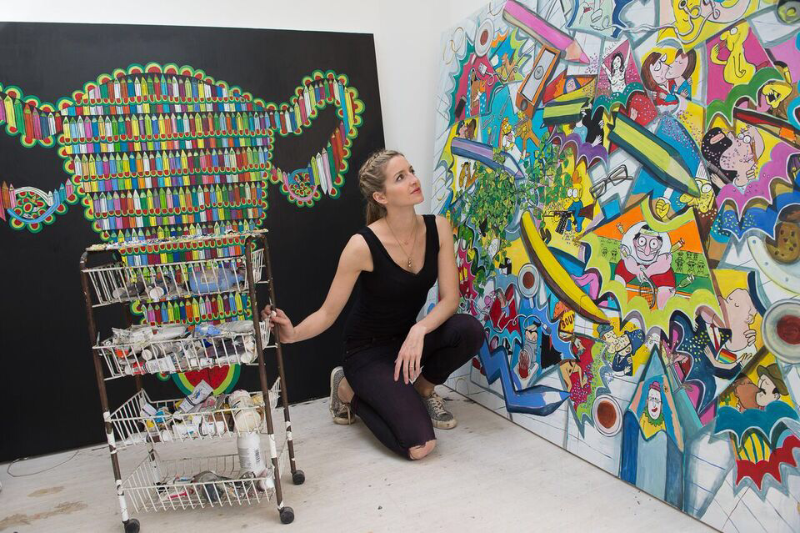An Interview with Celina Teague at Kristin Hjellegjerde Gallery

After the opening of her controversial, topical and vibrant exhibition, we were very eager to interview Celina to find out more about her thoughts and processes.
With a play on words by French philosopher René Descartes’ saying “I think therefore I am,” your collection has an effective title. How did you come to choose this?
I was thinking about this idea of our online reputation preceding us and the way in which we present ourselves, which is a little cut off from our actual minds. We put hashtags and tweets out so quickly that there is a disconnection between who we are inside and how we present ourselves online. We are very manicured on social media, often a world apart from the way we are at home. It’s an entirely new language – we don’t know where it will take us and I’m not entirely sure we know what we are doing!
How does this show differ from your previous ones?
It’s the first show where I feel like I’m really starting to know what sort of artist I am and where I’m interested in going. In other shows, the concept wasn’t as cohesive as this one – I was finding my feet. I’ve given this show my heart and soul and I know that it’s the best I can do right now.
The messages of the collection might come across with a negative view on social media. What is your view on the topic?
Social media – especially Twitter – does seem to be shining a light on some nasty, mob-like behaviour. It’s all too easy, for instance, not to give much thought to sending off a cruel tweet, because you do it anonymously and without seeing the consequences. But social media has loads of fantastic benefits, such as promoting awareness about a whole variety of causes. Social media has the potential to mobilise us to make the world a better place.
Are you on social media yourself?
Yes. I use Facebook and Instagram but I’m not on Twitter much. I tend to just retweet what comes my way. I do post about causes that move me, especially concerning animal and environmental issues. But I’m not a daily tweeter by any means.
What inspired the signature painting I Think Therefore I #?
The character in this painting draws from my own and other people’s Instagram feeds. The subject is a semi-transparent creature made of emojis and stereotypical hashtags. She poses with spread legs while taking a selfie. She is covered slogans and hashtags. She is an activist, a capitalist, a socialist, a narcissist, a traveller stuck in a room, and her head is cut off from her body. She is an amalgamation of everything I see (and, worryingly, some of what I am!) on Instagram.
What do you think the digital future holds?
I would love to see where we will be in 20 years time, or even in five. I wonder if we are going to move away from this narcissistic drive or delve further into it. Social media is changing all the time. Just think of how much it’s changed just in the last two years. I do wonder about the risks of our becoming numb to the endless stream of horrible news stories, and what that might mean for our capacity to empathise with others.
There is a focus on stories from the news within your work – how do you decide what to use?
It’s very personal. I paint about the stories that I can’t shake off when I go to bed. And about the stories that I think should not be forgotten tomorrow.
With this focus on #BringBackOurGirls, I Am No One is a pretty powerful, and quite upsetting, piece.
The BringBackOurGirls hashtag spread like wildfire and rightly so. It’s a horrific story – as bad and sad as it can get. 276 girls were abducted and never heard of again. These girls must not be forgotten.
What made you decide to feature the controversial topic of the Charlie Hebdo attack so frequently in this collection, and did you have any concerns in bringing it all back up?
In the aftermath of those 12 people losing their lives – in a violent attack on free speech – it seemed that everyone had an opinion on the subject but, as it turns out, many didn’t even know what Charlie Hebdo was. This is what happens on social media, people get really excited about things without knowing any of the facts. But it was clear that uncomfortable issues had been brought to light and I felt a sense that people were afraid to talk about some of these deeper points. I wanted to make my own mind up. It certainly is an inflammatory and complex issue and I was careful to deal with it in a sensitive and honest way that would open up a discussion, rather that close it off.
Do you think some people are exploiting freedom of speech?
Oliver Wendell Holmes Junior said: “Your liberty to swing your fist ends just where my nose begins.” It’s a fair point! I don’t feel we need further limits on free speech. People speak of having a responsibility with free speech, and it’s true. Ideally we wouldn’t be pushing people’s buttons or disrespecting others. But free speech is allowing someone to say something you don’t like or don’t agree with. It’s your right to then disagree as passionately as you’d like. I do feel it’s important that uncomfortable discussions are not swept under the carpet, but thrashed out in the open, on an intellectual playing field.
Do you find it more effective to express your opinions through your artwork than the internet?
I love that painting is a totally different language – far removed from everything to do with social media. A painting does not deal in “spin”. It is a medium of infinite possibilities. Take Picasso’s Guernica, for example. It’s a painting that speaks about the horrors of war better than any article ever could. Painting feels a world apart from social media.
What was your process of designing these abstract compositions?
Well, I just let myself go! I don’t do much – if any – preparatory work, so it’s always a wild experiment. That’s why my paintings tend to take me such a long time – I’m working things out as I go along and coming across many dead ends along the way.
How has your style of painting developed over the years?
I have always painted about real life events that seem to linger in my mind – often the ones that disturb me in some way. The way I used to paint was very direct and hard-hitting – certainly not nuanced. At art school my tutor encouraged me to think more carefully about the choices I made, rather than just shooting from the hip. And I took that advice. I’m not interested in conclusions so much as exploring subjects in a more layered way – if that makes any sense. I find the more I delve into the subject matter of some of my paintings, the more complex it becomes.
What advice can you give to aspiring artists?
Work hard, take risks, really go into your mind and push yourself in every way. Put in the hours!
Emily D’Silva
For further information about Celina Teague visit here.

























Facebook
Twitter
Instagram
YouTube
RSS